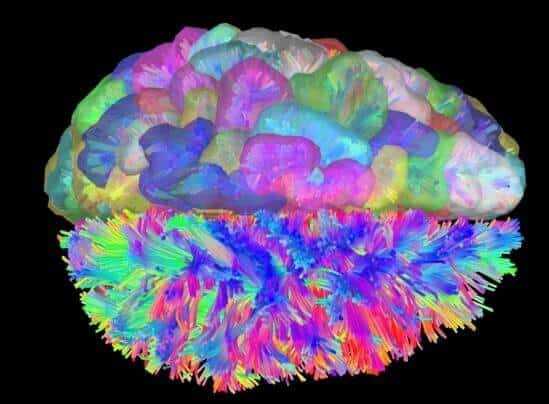The human brain does not come with an operating manual. However, a group of scientists from UC Santa Barbara and the University of Pennsylvania have developed a way to convert structural brain imaging techniques into “wiring diagrams” of connections between brain regions.
Three researchers from UCSB’s Department of Psychological & Brain Sciences — Michael Miller, Scott Grafton and Matt Cieslak — used the structure of neural networks to reveal the fundamental rules that govern which parts of the brain are most able to exert cognitive control over thoughts and actions. This study is the first to provide a mechanistic explanation for how the frontal cortex exerts control over the trillions of individual neurons that allow people to stay focused on one task or switch to a radically different one. The findings appear today in the journal Nature Communications.
“Particular regions of your brain are predisposed to control your thoughts based on where they lie in relation to other regions,” said Miller, a UCSB psychology professor and co-author of the paper. “The regions on the ‘outskirts’ can perform a very specific kind of control. They can move the system to distant states, like switching from working at your job to playing with your kids.”
This new research weds cutting-edge neuroscience with the emerging field of network science, which is often used to study social systems. By applying control theory — a field traditionally used to study electrical and mechanical systems — the investigators show that being on the outskirts of the brain is necessary for the frontal cortex to dynamically control the direction of thoughts and goal-directed behavior.
“We need a basic theory of how the brain controls itself, and to get there, we suggest treating the brain as an engineering system,” said senior author Danielle Bassett, the Skirkanich Assistant Professor of Innovation in Penn’s School of Engineering and Applied Science. “Cognitive control is a lot like engineering control: You model the system’s dynamics by identifying key points; if I push on that one piece or pull this lever, I can offer a prediction of how it’s going to affect other parts of the network.”
By applying control theory equations to the wiring diagrams generated from brain scans, the researchers showed that the geographical and functional differences between regions of the brain are linked. While the analysis cannot say whether the frontal cortex’s location or its role evolved first, it suggests that part of the frontal cortex’s ability to control executive function depends on its distance from other parts of the brain network.
“This study heralds a new wave of network science, grounded in rigorous control theory,” said co-author Grafton, director of UCSB’s Brain Imaging Center. “When applied to state-of-the-art brain imaging data we begin to see some of the design tradeoffs inherent in the architecture of brain connections.”
Regions that are most interconnected — and therefore more internal to the network — are very good at moving the brain into nearby states — for example, from writing someone an email to speaking with that person on the phone. “What’s particularly interesting if we look at where those inner nodes are, they’re all in ‘default mode’ regions, which are the regions that are active when you’re resting,” said Bassett, a former postdoctoral research associate in Grafton’s Action Lab at UCSB. “This makes sense, because if you were engineering an optimal system, you would want to put its baseline where it can get to most of the places it has to go pretty easily.”
According to co-author Cieslak, this type of holistic understanding of the relationship between brain regions’ locations and their roles is necessary for tailoring better treatments for people who have lost executive function due to disease or injury. He noted that such fundamental understanding of how the brain controls its activity could help lead to better interventions for medical conditions associated with reduced cognitive control, such as autism, schizophrenia or dementia.
In addition to Bassett and the UCSB co-authors, other contributors include lead author Shi Gu and John Medaglia of the University of Pennsylvania; Fabio Pasqualetti of UC Riverside; Jean Vettel and Alfred Yu of the Army Research Laboratory (ARL); and Qawi Telesford and Ari Kahn, joint ARL-Penn scientists.
The research was supported by grants from the Alfred P. Sloan Foundation, the U.S. Army Research Office through its Institute for Collaborative Biotechnologies, the National Science Foundation and the Public Health Service.


